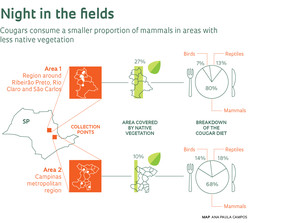
Eduardo CesarLess succulent diet: cougars also hunt animals in planted fieldsEduardo Cesar
The cougars that live in the forested areas of the Campinas metropolitan region may dream about a daily banquet of anteaters or peccaries, which are now rare in those parts. Unfortunately, these large suburban felines have to be content with a less succulent diet consisting mainly of rodents, birds and snakes. In addition, most of their hunting occurs not in the forest, but in sugarcane and other planted fields.
The cougar’s change of diet has become apparent in light of a pioneering analysis by researchers from the University of São Paulo (USP), the University of Campinas (Unicamp) and the Chico Mendes Institute for Biodiversity (ICMBio). They collected fecal samples from these animals and, using visual and physicochemical analysis, reconstructed the cougars’ diet and determined where their prey came from. “Cougars and their wild prey have no alternative,” explains biologist Marcelo Magioli of the Luiz de Queiroz College of Agriculture (Esalq) at USP in Piracicaba, first author of a paper that described the diet of cougars in São Paulo in the July 2014 issue of the journal Biotropica. “Unable to find food in the forest remnants, felines have adapted to looking for prey on farmland.”
Before researching the cougars’ diet, Magioli conducted a survey of medium-sized and large mammals living in the largest fragments of native vegetation in a 665-square-kilometer (km²) area that includes Campinas and neighboring municipalities, for his master’s thesis under the supervision of Kátia Ferraz at Esalq. In the survey he identified 27 species, seven of which are endangered in the state of São Paulo.
Threatened with extinction, the cougar (Puma concolor) is the last of the large predators in many of the state’s forest fragments, and it sits at the top of the food chain. Along with its main competitor—the jaguar (Panthera onca), which is nearly extinct in the state—the cougar is left to prey on capybaras and other herbivores, which keeps the population of such animals from becoming pests. In nature, competition for food between cougars and other large carnivores such as ocelots and maned wolves helps control the population of other animals. But reduction of native vegetation and hunting are slowly reducing the numbers of these felines in the Americas. “We need more accurate data on the cougar population in São Paulo State, but we think it is dwindling,” says biologist Lilian Bonjorne de Almeida of the National Center for Research and Conservation of Carnivorous Mammals at ICMBio, who studies the cougars of the Serra da Cantareira mountain range in the São Paulo metropolitan region.
Over a year’s time, Magioli explored along dirt roads and trails in the forests of Campinas and nearby municipalities looking for animal tracks, footprints and droppings. He collected 30 fecal samples, which were analyzed by biologists Eleonore Setz and Mariana Canhoto, both at Unicamp. They identified pieces of bone, claws, teeth, skin, feathers and scales of prey eaten by the cougars, in addition to fur from the cougars themselves. Like domestic cats, cougars ingest their own fur through grooming.
 Biologists Marcelo Moreira and Plínio de Camargo of the USP Center for Nuclear Energy in Agriculture then performed a physicochemical analysis of the material, measuring the ratios of two types of carbon atoms that have different masses—the stable isotopes. “Differences in these isotope ratios enable us to determine whether the cougars’ prey fed more on resources from the forest or from sugarcane fields,” Magioli explains.
Biologists Marcelo Moreira and Plínio de Camargo of the USP Center for Nuclear Energy in Agriculture then performed a physicochemical analysis of the material, measuring the ratios of two types of carbon atoms that have different masses—the stable isotopes. “Differences in these isotope ratios enable us to determine whether the cougars’ prey fed more on resources from the forest or from sugarcane fields,” Magioli explains.
Pacas, birds and snakes
The team examined 34 additional fecal samples obtained by biologist Renata Miotto, also from Esalq, in a 1,700-km² area around the cities of Ribeirão Preto, Rio Claro and São Carlos, farther away from the state capital (see Pesquisa FAPESP Issue No. 199). Although both regions include major urban centers and rural areas where sugarcane predominates, the section that Miotto studied has a proportionately larger area of native vegetation.
The diet of the cougars around Ribeirão Preto, São Carlos and Rio Claro included more large animals that have been disappearing from the Campinas area, such as tamanduas (arboreal anteaters) and peccaries. The cougars around Campinas also consume large mammals such as pacas and capybaras, but they feed more on small animals such as birds and snakes.
The carbon isotope analysis also revealed that many animals hunted by cougars in both regions have a diet that is very much split between native plants and agricultural crops. But the proportion of prey that feed preferentially on planted crops increases in the less wooded areas: nearly 50% consumed mainly plants cultivated by man in Campinas, a figure that dropped to 17% in Ribeirão Preto and São Carlos. “Herbivores are eating more planted crops because of lack of native vegetation,” Magioli explains. “Especially the capybara, which prefers more open areas and has adapted well to the sugarcane fields.”
Magioli and his colleagues hope this information will be useful for conservation of the species and for the Jaguar Corridor Project. Under the coordination of Ademar Romero, an economist at Unicamp, and Márcia Rodrigues, an environmental analyst at ICMBio, this program seeks to boost the conservation of forest fragments in Campinas and create corridors to facilitate animal movement between fragments. “Although some animals may adapt to an agricultural landscape,” Magioli says, “fragments of native vegetation are essential to their survival.”
Scientific article
MAGIOLI, M. et al. Stable isotope evidence of Puma concolor (Felidae) feeding patterns in agricultural landscapes in Southeastern Brazil. Biotropica. v. 46, n.4. Jul. 2014.

